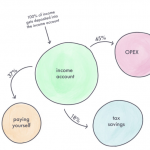Startups: Budgeting, Financial Planning & Business Forecasting for 2021 Starts Now
It’s already December and this dumpster fire of a year is a few weeks from being over, which I am sure that everyone is hoping and praying that next year 2021 brings better times. One of daunting tasks for startup founders and small business owners is strategic planning and financial cash-flow forecasting. Now is the time to begin getting your startup businesses financial plan or forecasting models together now before the year starts so you will know what you will need to execute. The management consulting firm Mckinsey & Co published an article titled “Memo to the CFO: A new approach to 2021 budgeting starts now” in September that explains how the financial-planning process for 2021 presents an opportunity to turn hard-earned lessons from the COVID-19 pandemic into an enduring exercise in linking strategy to value.
Recently a Forbes Contributor, Moira Vetter published an article titled Business Forecasting For 2021 As If 2020 Never Happened, where she states “many strategic planning efforts are “save as” versions of previous years. You may calculate a nominal change in the percentage of growth or perhaps forecasting for a flat or decreased year, but your activities remain the same.” But she also explains that before you move your financial targets you should also take into account the state of the world and your company’s new place in it.
How to do Financial Planning for Your Startup
First, inorder to put together a decent financial forecast or plan your company should really think about what your business’s long-term strategy and goals are? Then you will want to align your financial plan. You can think of this financial plan, guidance or outlook as a near term road map of this vision. Now just as some technology and digital startups saw a boost in 2020 because of the pandemic such as Zoom, Instacart, Doordash, Docusign, Peloton, or Robinhood, you need to think about are the trends related to your business or industry and what will 2021 look like as a business environment. Is it slowing down or or going to continue to grow? Even with a Vaccine no one is sure that we will ever “go back to normal” meaning some consumer behaviors that were changed and adopted may continue even after the pandemic. And regardless of how your industry sector has fared during this pandemic Mckinsey stated that what is “common to all businesses, however, is the need for greater speed and cost control amid ongoing, unprecedented uncertainty.” Ms Vetter suggests that that you should try think of this 2020 with a blank slate and go back to some of your core fundamentals although as I had mentioned before even billionaire entrepreneur Mark Cuban thinks that everything from office work to business travel will change going forward. She listed out a few areas or key performance indicators to think about.
- Is your industry or business sector growing, treading water, declining, or potentially becoming no longer in demand? If your answers are in the last two slots, it may be time to pivot or reinvent your business.
- Who are your key targets and customers? Not the ones that bought from you in 2019, but rather the ones that will be spending money in 2021.
- Are they increasing or decreasing their spending on what you do?
- Are they increasing their spending in other product categories or support that you could offer but haven’t been promoting?
- Are your sales opportunities one-time deals or ongoing recurring revenue propositions? If your immediate opportunities are one-time only, are you leveraging contractors and strategic partners for these rather than staffing with full-time employees who will be without something to do in 3 or 4 months?
- Does your staffing/resource plan map to your sales/revenue plan? For example, if you do tech support or managed services, are 80% of your techs trained in a system that isn’t in demand while the other 20% are overloaded with requests? Can you cross-train them to open up your bandwidth for services that are in demand?
What about Key Performance Indicators?

Scott Orn, of Kruze Consulting recently published a financial planning article that mentions KPIs for startups. Now depending on what type of a product or services your business provides, if you are a startup that manufactures physical goods or offers consumer or enterprise software products or apps (SAAS) you may want to use key performance indicators, KPIs, to drive their financial projections revenue model or key assumptions. So some of these could things like:
- average selling price
- number of customers
- number of engineers on the development side
- productivity per engineer, and so on.
The number of KPIs could range from 3 to 5, and try to use the ones that drive your to really drive your business revenue. Mr Orn, says that “most people start from the top and they go top-down.”
Some companies will use the KPIs to figure out what the revenue projections are going to be. And then they start thinking about how they need to support, or how they need to build the organization to support that revenue. If you are a venture backed or funded startup you may want to do a 3 year financial forecast or model with most of the focus being on this immediate upcoming year because that’s where you have the most control and visibility. This also means you may bring in and collaborate with your salespeople, sales engineers, developers, engineers, people who are in operations like HR, recruiting etc. If you have investors and have big growth plans then remember that your stakeholders, your employees, your investors, they are all going to care what that three-year plan really looks like, because it’s the trajectory of the company. So if you are a high growth startup and have plans to go from $1 to $5 to $10 million in revenue, hypothetically, and there’s a lot of things that need to happen for a company to make that transition from $1 to $10 million in revenue. Having these goals and financial projection targets planned out, knowing where you’re trying to go, really helps your management team keep everyone involved and motivated.
Is it any different if you are a CapEx heavy organization such as pharma, biotech, manufacturing, or robotics? For these types of organizations, Mr Orn suggests that “you have to plan ahead on your capital expenditures.” It’s crucial to calculate how much equipment will need to be purchased, or when will it get delivered, and will any accessories or parts need to go along with that equipment. Which makes planning for hardware, pharmaceutical, robotics, or medical technology companies much more difficult than simply a SAAS, or direct to consumer (DTC) internet company.
That is why it is suggested that you plan ahead on those purchases and buffer in some lag. Meaning when you make a large purchase order for CapEx equipment it may end up running a few months late.
Fundraising
If you are a startup that is planning on raising Seed Funding, or a Series A investment, then this aspect will be an important part of your financial plan, since typically startups raise money on an 18-month cycle, and some others every 12 months, or every 24 months. As you are looking ahead, you should be paying attention to what milestones you need to hit so that you can go back to the VC market and raise more investment money. And if you’re cashflow positive, That’s great, but you want to know where you’re going and know what you need to do so that you can raise capital. If things are not going as planned there are other sources funding such as bridge loans and venture debt. So there is a lot of liquidity out with a bunch of lenders who are for companies to invest their money into. So if your startup company is performing well, it gets much easier in the fundraising process where there are a number of lenders who are looking to capital to work. And if you run the risk of running out of money and need a bridge you can go out to the debt markets and if you need a six months runway extension And that way you will know you’re going to be able to hit the milestones you planned in your financial forecasting model.
Board Approval
Now if you are a VC funded startup, then you have investors and a board and sometimes for certain decisions you need to get approval from the board. Mr Orn states in his article that ”sometimes, the boards, even in the stock purchase agreement and investor rights agreements, will include that they have the right to approve the financial plan for the year.” So then in this case you would need to present your financial plan and budget for the upcoming year to your board. That is why I am writing this article and suggesting that companies should start the planning process for the budget now or at the very least in January. Because if you have a board to answer to, and if there are any disagreements and you can’t get it worked out and approved by the board in December then you will already be running into January anyway. So if you are planning on growing the company and hiring a bunch of new employees, and you are collecting resumes, and starting to interview potential candidates you can usually start hiring those people that you need by the end of January or February. If you’re getting this board deck and board presentation approved in January, it puts you on a month delay and that’s not a huge deal.

Most recruiting doesn’t really ramp up until the end of January. But starting earlier can be helpful. It is also good to have enough time if you need to have meetings with your board. It good to reel them into the process early so that they’re aren’t any surprises and you can figure out what their assumptions are in regards to spending and financial goals. It’s also quite common to have board members not approve of the financial plan on the first go round and suggest changes. It usually comes down to because they have invested a lot of capital in your startup and they would like to see a more aggressive plan. Meaning the want to see it produce big numbers and big exit down the line either an IPO or getting acquired by a larger company.
This is often why they may challenge you to be more aggressive.
Executing the Plan
The next step of financial planning for 2021 is implementing it. And a lot of it is getting those orders in for CapEx, getting HR, ramping up recruiting, making the time in your schedule and team members’ schedules to actually do the interviewing and attract high quality talent. Sometimes companies can end up missing their numbers because the plan was based upon the assumption of bringing in a certain number of contributors whether that is sales people, marketing or engineers into the company. And they don’t end up making the hires of these positions in time. So they end up missing their numbers by a quarter. Meaning the quicker you can execute on the plan, the faster you get those key positions filled and start making meaningful progress in 2021. And you will end up increasing your current valuation if you are raising more capital. You will gain more traction. And it ends up making your investors, team and board more happy. But even more crucial, you feel good because you can see that you are making progress on leading your company.
Conclusion
A website called The CEO”s right hand published an article about business trends and financial planning and they explain that “no matter what the future holds, taking stock of your current situation and developing detailed financial models and cash flow forecasts will help you weather the inevitable ups and downs.” To ensure that you and your management team can anticipate and quickly adjust to a variety of market swings, include variable assumptions so you can easily perform “what-if scenario” queries. For example, you could model the impact of an increase or decrease in orders then manage your resources proactively by renegotiating contracts with major suppliers.
To finalize my point of this article, is that companies should not wait until after New Years to get started.
Now is the time to start planning for 2021. Get that financial plan done. You’ll sleep better. You’ll enjoy the holidays more and you’ll have just a great start in 2021! If you are a California based startup or small business and you have any questions or would like a free consultation about financial planning or budgeting don’t hesitate to contact us.











